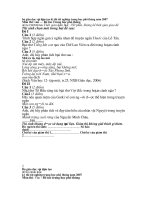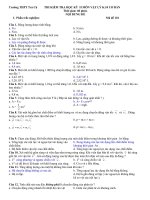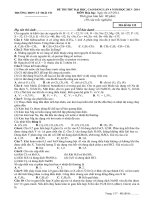Đề thi và đáp án CMO năm 2014
Bạn đang xem bản rút gọn của tài liệu. Xem và tải ngay bản đầy đủ của tài liệu tại đây (204.27 KB, 5 trang )
<span class='text_page_counter'>(1)</span><div class='page_container' data-page=1>
46
th<sub>Canadian Mathematical Olympiad</sub>
Wednesday, April 2, 2014
Problems and Solutions
1. Let<i>a</i>1<i>, a</i>2<i>, . . . , an</i>be positive real numbers whose product is 1. Show that the sum
<i>a</i>1
1 +<i>a</i>1
+ <i>a</i>2
(1 +<i>a</i>1)(1 +<i>a</i>2)
+ <i>a</i>3
(1 +<i>a</i>1)(1 +<i>a</i>2)(1 +<i>a</i>3)
+· · ·+ <i>an</i>
(1 +<i>a</i>1)(1 +<i>a</i>2)<i>· · ·</i>(1 +<i>an</i>)
is greater than or equal to 2
<i>n<sub>−</sub></i><sub>1</sub>
2<i>n</i> .
Solution. Note for that every positive integer<i>m</i>,
<i>am</i>
(1 +<i>a</i>1)(1 +<i>a</i>2)<i>· · ·</i>(1 +<i>am</i>)
= 1 +<i>am</i>
(1 +<i>a</i>1)(1 +<i>a</i>2)<i>· · ·</i>(1 +<i>am</i>)
<i>−</i> 1
(1 +<i>a</i>1)(1 +<i>a</i>2)<i>· · ·</i>(1 +<i>am</i>)
= 1
(1 +<i>a</i>1)<i>· · ·</i>(1 +<i>am−</i>1)
<i>−</i> 1
(1 +<i>a</i>1)<i>· · ·</i>(1 +<i>am</i>)
<i>.</i>
Therefore, if we let<i>bj</i> = (1 +<i>a</i>1)(1 +<i>a</i>2)<i>· · ·</i>(1 +<i>aj</i>), with <i>b</i>0 = 0, then by telescoping
sums,
<i>n</i>
X
<i>j</i>=1
<i>aj</i>
(1 +<i>a</i>1)<i>Ã Ã Ã</i>(1 +<i>aj</i>)
=
<i>n</i>
X
<i>j</i>=1
à
1
<i>bj</i>1
<i></i> 1
<i>bj</i>
ả
= 1<i></i> 1
<i>bn</i>
<i>.</i>
Note that <i>bn</i> = (1 +<i>a</i>1)(1 +<i>a</i>2)<i>· · ·</i>(1 +<i>an</i>) <i>≥</i> (2
<i>√</i>
<i>a</i>1)(2
<i>√</i>
<i>a</i>2)<i>· · ·</i>(2
<i>√</i>
<i>an</i>) = 2<i>n</i>, with
equality if and only if all <i>ai</i>’s equal to 1. Therefore,
1<i>−</i> 1
<i>bn</i> <i>≥</i>1<i>−</i>
1
2<i>n</i> =
2<i>n<sub>−</sub></i><sub>1</sub>
2<i>n</i> <i>.</i>
To check that this minimum can be obtained, substituting all <i>ai</i> = 1 to yield
1
2 +
1
22 +
1
23 +<i>. . .</i>+
1
2<i>n</i> =
2<i>n−</i>1<sub>+ 2</sub><i>n−</i>2<sub>+</sub><i><sub>. . .</sub></i><sub>+ 1</sub>
2<i>n</i> =
2<i>n<sub>−</sub></i><sub>1</sub>
2<i>n</i> <i>,</i>
</div>
<span class='text_page_counter'>(2)</span><div class='page_container' data-page=2>
2. Let<i>m</i>and<i>n</i>be odd positive integers. Each square of an<i>m</i>by<i>n</i>board is coloured
red or blue. A row is said to be red-dominated if there are more red squares than
blue squares in the row. A column is said to be blue-dominated if there are more
blue squares than red squares in the column. Determine the maximum possible value
of the number of red-dominated rows plus the number of blue-dominated columns.
Express your answer in terms of <i>m</i> and <i>n</i>.
Solution. The answer is<i>m</i>+<i>n−</i>2 if<i>m, n≥</i>3 and max{<i>m, n}</i>if one of<i>m, n</i>is equal
to 1.
Note that it is not possible that all rows are red-dominated and all columns are
blue-dominated. This is true, since the number of rows and columns are both odd,
the number of squares is odd. Hence, there are more squares of one color than the
other. Without loss of generality, suppose there are more red squares than blue
squares. Then it is not possible that for every column, there are more blue squares
than red squares. Hence, every column cannot be blue-dominated.
If one of<i>m, n</i>is equal to 1, say<i>m</i>without loss of generality, then by the claim, the
answer is less than <i>n</i>+ 1. The example where there are <i>n</i> blue-dominated columns
is by painting every square blue. There are 0 red-dominated rows. The sum of the
two is <i>n</i>= max{<i>m, n}.</i>
Now we handle the case <i>m, n≥</i>3.
There are <i>m</i> rows and <i>n</i> columns on the board. Hence, the answer is at most
<i>m</i>+<i>n</i>. We have already shown that the answer cannot be <i>m</i>+<i>n</i>.
Since <i>m, n</i> are odd, let <i>m</i> = 2<i>a−</i>1 and <i>n</i> = 2<i>b</i> <i>−</i>1 for some positive integers
<i>a, b</i>. Since <i>m, n≥</i> 3, <i>a, b</i> <i>≥</i> 2. We first show that the answer is not <i>m</i>+<i>n−</i>1. By
symmetry, it suffices to show that we cannot have all rows red-dominated and
all-but-one column blue-dominated. If all rows are red dominated, then each row has at least
<i>b</i>red squares. Hence, there are at least<i>bm</i>= (2<i>a−</i>1)<i>b</i> red squares. Since all-but-one
column is blue-dominated, there are at least 2<i>b−</i>2 blue-dominated columns. Each
such column then has at least <i>a</i> blue squares. Therefore, there are at least<i>a</i>(2<i>b−</i>2)
blue squares. Therefore, the board has at least (2<i>a−</i>1)<i>b</i>+<i>a</i>(2<i>b−</i>2) = 4<i>ab−b−</i>2<i>a</i>
squares. But the total number of squares on the board is
(2<i>a−</i>1)(2<i>b−</i>1) = 4<i>ab−</i>2<i>a−</i>2<i>b</i>+ 1 = 4<i>ab−</i>2<i>a−b−b</i>+ 1 <i><</i>4<i>ab−</i>2<i>a−b,</i>
which is true since<i>b≥</i>2. This is a contradiction. Therefore, the answer is less than
</div>
<span class='text_page_counter'>(3)</span><div class='page_container' data-page=3>
We now claim that there is a colouring of the board such that the number of
blue-dominated columns plus the number of red-blue-dominated rows is<i>m</i>+<i>n−</i>2; Colour the
first column entirely red, and the first row, minus the top-left corner, entirely blue.
The remaining uncoloured square is an even-by-even board. Colour the remaining
board in an alternating pattern (i.e. checkerboard pattern). Hence, on this
even-by-even board, each row has the same number of red squares as blue squares and
each column has the same number of red squares as blue squares. Then on the
whole board, since the top row, minus the top-left square is blue, all columns, but
the leftmost column, are blue-dominated. Hence, there are <i>n−</i>1 blue-dominated
columns. Since the left column is red, all rows but the top row are red dominated.
Hence, there are <i>m</i> <i>−</i>1 red-dominated rows. The sum of these two quantities is
<i>m</i>+<i>n−</i>2, as desired.
3. Let <i>p</i> be a fixed odd prime. A <i>p</i>-tuple (<i>a</i>1<i>, a</i>2<i>, a</i>3<i>, . . . , ap</i>) of integers is said to be
<i>good</i> if
(i) 0<i>≤ai</i> <i>≤p−</i>1 for all <i>i</i>, and
(ii) <i>a</i>1+<i>a</i>2+<i>a</i>3+<i>· · ·</i>+<i>ap</i> is not divisible by <i>p</i>, and
(iii) <i>a</i>1<i>a</i>2+<i>a</i>2<i>a</i>3+<i>a</i>3<i>a</i>4+<i>· · ·</i>+<i>apa</i>1 is divisible by <i>p</i>.
Determine the number of good<i>p</i>-tuples.
Solution. Let <i>S</i> be the set of all sequences (<i>b</i>1<i>, b</i>2<i>, . . . , bp</i>) of numbers from the
set <i>{0,</i>1<i>,</i>2<i>, . . . , p−</i>1} such that <i>b</i>1 +<i>b</i>2 +<i>· · ·</i>+<i>bp</i> is not divisible by <i>p</i>. We show
that <i>|S|</i> = <i>pp</i> <i><sub>−</sub><sub>p</sub>p−</i>1<sub>. For let</sub> <i><sub>b</sub></i>
1<i>, b</i>2<i>, . . . , bp−</i>1 be an arbitrary sequence of numbers
chosen from <i>{0,</i>1<i>,</i>2<i>, . . . , p</i> <i>−</i>1}. There are exactly <i>p−</i>1 choices for <i>bp</i> such that
<i>b</i>1+<i>b</i>2+<i>· · ·</i>+<i>bp−</i>1+<i>bp</i> <i>6≡</i>0 (mod <i>p</i>), and therefore <i>|S|</i>=<i>pp−</i>1(<i>p−</i>1) =<i>pp−pp−</i>1.
Now it will be shown that the number of good sequences in <i>S</i> is 1
<i>p|S|. For a</i>
sequence<i>B</i> = (<i>b</i>1<i>, b</i>2<i>, . . . , bp</i>) in <i>S</i>, define the sequence <i>Bk</i> = (<i>a</i>1<i>, a</i>2<i>, . . . , ap</i>) by
<i>ai</i> =<i>bi−b</i>1 +<i>k</i> mod<i>p</i>
for 1<i>≤i≤p</i>. Now note that <i>B</i> in<i>S</i> implies that
<i>a</i>1+<i>a</i>2+<i>· · ·</i>+<i>ap</i> <i>≡</i>(<i>b</i>1+<i>b</i>2+<i>· · ·</i>+<i>bp</i>)<i>−pb</i>1+<i>pk≡</i>(<i>b</i>1+<i>b</i>2+<i>· · ·</i>+<i>bp</i>)<i>6≡</i>0 (mod <i>p</i>)
</div>
<span class='text_page_counter'>(4)</span><div class='page_container' data-page=4>
Now define the <i>cycle</i> of <i>B</i> as the set <i>{B</i>0<i>, B</i>1<i>, . . . , Bp−</i>1<i>}. Note that</i> <i>B</i> is in its
own cycle since<i>B</i> =<i>Bk</i> where<i>k</i> =<i>b</i>1. Now note that since every sequence in<i>S</i> is in
exactly one cycle, <i>S</i> is the disjoint union of cycles.
Now it will be shown that exactly one sequence per cycle is good. Consider
an arbitrary cycle <i>B</i>0<i>, B</i>1<i>, . . . , Bp−</i>1, and let <i>B</i>0 = (<i>b</i>1<i>, b</i>2<i>, . . . , bp</i>) where <i>b</i>0 = 0, and
note that <i>Bk</i> = (<i>b</i>1 +<i>k, b</i>2+<i>k, . . . , bp</i> +<i>k</i>) mod <i>p</i>. Let <i>u</i> = <i>b</i>1+<i>b</i>2 +<i>· · ·</i>+<i>bp</i>, and
<i>v</i> =<i>b</i>1<i>b</i>2+<i>b</i>2<i>b</i>3+<i>· · ·</i>+<i>bpb</i>1 and note that (<i>b</i>1+<i>k</i>)(<i>b</i>2+<i>k</i>) + (<i>b</i>2+<i>k</i>)(<i>b</i>3+<i>k</i>)) +<i>· · ·</i>+
(<i>bp</i>+<i>k</i>)(<i>b</i>1+<i>k</i>) =<i>u</i>+ 2<i>kv</i> mod<i>p</i> for all 0 <i>≤k</i> <i>≤p−</i>1. Since 2<i>v</i> is not divisible by
<i>p</i>, there is exactly one value of <i>k</i> with 0 <i>≤</i> <i>k</i> <i>≤</i> <i>p−</i>1 such that <i>p</i> divides <i>u</i>+ 2<i>kv</i>
and it is exactly for this value of <i>k</i> that <i>Bk</i> is good. This shows that exactly one
sequence per cycle is good and therefore that the number of good sequences in <i>S</i> is
1
<i>p|S|, which is</i> <i>pp−</i>1<i>−pp−</i>2.
4. The quadrilateral <i>ABCD</i> is inscribed in a circle. The point<i>P</i> lies in the interior
of <i>ABCD</i>, and ∠<i>P AB</i> =∠<i>P BC</i> =∠<i>P CD</i> =∠<i>P DA</i>. The lines <i>AD</i> and <i>BC</i> meet
at<i>Q</i>, and the lines <i>AB</i> and <i>CD</i> meet at<i>R</i>. Prove that the lines <i>P Q</i> and <i>P R</i> form
the same angle as the diagonals of <i>ABCD</i>.
Solution. . Let Γ be the circumcircle of quadrilateral <i>ABCD</i>. Let <i>α</i> = ∠<i>P AB</i> =
∠<i>P BC</i>∠<i>P CD</i> = ∠<i>P DA</i> and let <i>T</i>1 , <i>T</i>2 , <i>T</i>3 and <i>T</i>4 denote the circumcircles of
triangles <i>AP D</i>, <i>BP C</i>, <i>AP B</i> and <i>CP D</i>, respectively. Let <i>M</i> be the intersection of
<i>T</i>1 with line <i>RP</i> and let <i>N</i> be the intersection of<i>T</i>3 with line<i>SP</i>. Also let<i>X</i> denote
the intersection of diagonals<i>AC</i> and <i>BD</i>.
By power of a point for circles <i>T</i>1 and Γ, it follows that <i>RM</i> <i>·RP</i> =<i>RA·RD</i> =
<i>RB·RC</i> which implies that the quadrilateral <i>BMP C</i> is cyclic and <i>M</i> lies on <i>T</i>2.
Therefore∠<i>P MB</i> =∠<i>P CB</i> =<i>α</i>=∠<i>P AB</i> =∠<i>DMP</i> where all angles are directed.
This implies that <i>M</i> lies on the diagonal<i>BD</i> and also that ∠<i>XMP</i> =∠<i>DMP</i> =<i>α</i>.
By a symmetric argument applied to <i>S</i>, <i>T</i>3 and <i>T</i>4, it follows that <i>N</i> lies on <i>T</i>4 and
that <i>N</i> lies on diagonal <i>AC</i> with ∠<i>XN P</i> = <i>α</i>. Therefore ∠<i>XM P</i> = ∠<i>XNP</i> and
<i>X</i>,<i>M</i>, <i>P</i> and <i>N</i> are concyclic. This implies that the angle formed by lines <i>MP</i> and
<i>NP</i> is equal to one of the angles formed by lines <i>MX</i> and <i>NX</i>. The fact that <i>M</i>
</div>
<span class='text_page_counter'>(5)</span><div class='page_container' data-page=5>
Solution. We will think of all numbers as being residues mod <i>k</i>. Consider the
following strategy:
<i>•</i> If there are less than <i>k−</i>1 non-zero numbers, then stop.
<i>•</i> If the first number is 0, then recursively solve on the remaining numbers.
<i>•</i> If the first number is<i>j</i> with 0<i>< j < k</i>, then choose the interval stretching from
the first number to the <i>j</i>th-last non-zero number.
First note that this strategy is indeed well defined. The first number must have
value between 0 and<i>k−</i>1, and if we do not stop immediately, then there are at least
<i>k−</i>1 non-zero numbers, and hence the third step can be performed.
For each <i>j</i> with 1<i>≤j</i> <i>≤k−</i>2, we claim the first number can take on the value of
<i>j</i> at most a finite number of times without taking on the value of<i>j−</i>1 in between. If
this were to fail, then every time the first number became<i>j</i>, I would have to add 1 to
the selected numbers to avoid making it<i>j−</i>1. This will always increase the <i>j</i>-th last
non-zero number, and that number will never be changed by other steps. Therefore,
that number would eventually become 0, and the next last non-zero number would
eventually become zero, and so on, until the first number itself becomes the<i>j</i>-th last
non-zero number, at which point we are done since<i>j</i> <i>≤k−</i>2.
Rephrasing slightly, if 1<i>≤j</i> <i>≤k−</i>2, the first number can take on the value of <i>j</i>
at most a finite number of times between each time it takes on the value of<i>j−</i>1. It
then immediately follows that if the first number can take on the value of <i>j</i> <i>−</i>1 at
most a finite number of times, then it can also only take on the value of <i>j</i> a finite
number of times. However, if it ever takes on the value of 0, we have already reduced
the problem to<i>n−</i>1, so we can assume that never happens. It then follows that the
first number can take on all the values 0<i>,</i>1<i>,</i>2<i>, . . . , k</i> <i>−</i>2 at most a finite number of
times.
</div>
<!--links-->









